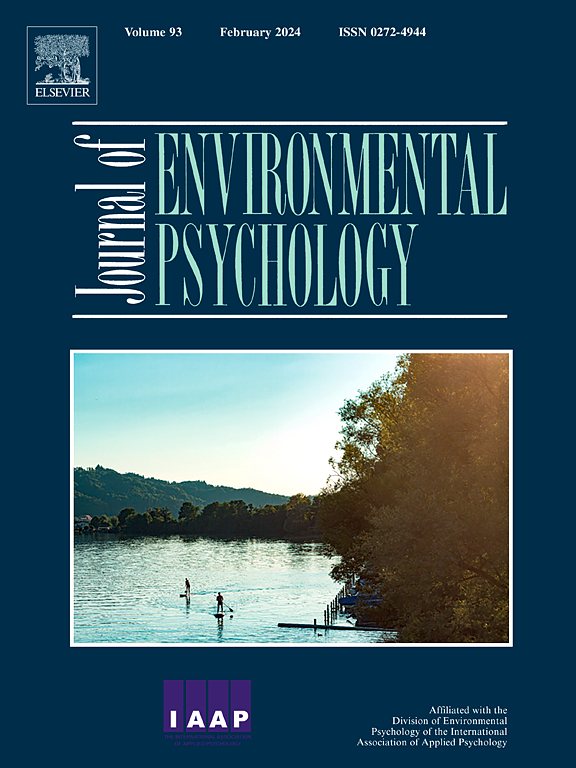Nature exposure impacts affect and brain activation in health and major depression
IF 7
1区 心理学
Q1 ENVIRONMENTAL STUDIES
引用次数: 0
Abstract
Considerable research attention has been devoted to the negative impact of urban compared to natural environments on mental health and well-being. Recent studies have addressed the neurobiological underpinnings but have mostly focused on post-hoc effects. How brain activation is acutely changed during nature exposure has barely been investigated. This study sought to assess how affect and cortical activation patterns in a natural environment differ from those in an urban area and how this is influenced by depressive symptoms. To this end, portable functional near-infrared spectroscopy (fNIRS) was used in a 16x16 optode layout to measure cortical activation during a 10-min stay in either a natural or urban environment in 16 patients with major depression and 16 healthy controls. Effects on affect and cognition were explored using questionnaires. Across the whole sample, nature exposure reduced negative affect. When fNIRS channels were allocated to anatomically informed regions of interest, we found decreased spontaneous neural activity in the left ventrolateral prefrontal cortex (PFC) and the right superior temporal gyrus during nature compared to urban exposure, albeit uncorrected for multiple comparisons. Using a data-driven approach, cluster-based permutation testing confirmed a reduced activation of the left PFC during nature exposure. Brain activation remained uninfluenced by depression or antidepressant medication, but depressive symptoms correlated with a reduction of negative affect. Given the limited sample size, these data should be treated as exploratory and only preliminary evidence to suggest that time spent in nature might reduce the strain on brain regions involved in regulating negative emotions and social stress, largely unaffected by depression. These findings warrant replication in larger, future studies.
自然暴露影响健康和重度抑郁症患者的情绪和大脑活动
与自然环境相比,城市环境对心理健康和福祉的负面影响已经得到了相当多的研究关注。最近的研究已经解决了神经生物学基础,但主要集中在事后效应上。在大自然中,大脑的活动是如何剧烈变化的,这一点几乎没有被研究过。这项研究试图评估在自然环境中的情绪和皮层激活模式与在城市地区的有何不同,以及这是如何受到抑郁症状的影响。为此,在16x16光电布局中使用便携式功能近红外光谱(fNIRS)来测量16名重度抑郁症患者和16名健康对照者在自然或城市环境中停留10分钟的皮质激活情况。采用问卷调查的方式探讨对情绪和认知的影响。在整个样本中,接触自然减少了负面影响。当fNIRS通道被分配到解剖学信息感兴趣的区域时,我们发现,与城市暴露相比,在自然环境中,左侧腹外侧前额叶皮层(PFC)和右侧颞上回的自发神经活动减少,尽管多次比较未进行校正。使用数据驱动的方法,基于簇的排列测试证实,在自然暴露期间,左侧PFC的激活减少。大脑活动不受抑郁或抗抑郁药物的影响,但抑郁症状与消极情绪的减少相关。鉴于样本量有限,这些数据应该被视为探索性的,只是初步的证据,表明在大自然中度过的时间可能会减少涉及调节负面情绪和社会压力的大脑区域的压力,在很大程度上不受抑郁症的影响。这些发现值得在未来更大规模的研究中复制。
本文章由计算机程序翻译,如有差异,请以英文原文为准。
求助全文
约1分钟内获得全文
求助全文
来源期刊

Journal of Environmental Psychology
Multiple-
CiteScore
10.60
自引率
8.70%
发文量
140
审稿时长
62 days
期刊介绍:
The Journal of Environmental Psychology is the premier journal in the field, serving individuals in a wide range of disciplines who have an interest in the scientific study of the transactions and interrelationships between people and their surroundings (including built, social, natural and virtual environments, the use and abuse of nature and natural resources, and sustainability-related behavior). The journal publishes internationally contributed empirical studies and reviews of research on these topics that advance new insights. As an important forum for the field, the journal publishes some of the most influential papers in the discipline that reflect the scientific development of environmental psychology. Contributions on theoretical, methodological, and practical aspects of all human-environment interactions are welcome, along with innovative or interdisciplinary approaches that have a psychological emphasis. Research areas include: •Psychological and behavioral aspects of people and nature •Cognitive mapping, spatial cognition and wayfinding •Ecological consequences of human actions •Theories of place, place attachment, and place identity •Environmental risks and hazards: perception, behavior, and management •Perception and evaluation of buildings and natural landscapes •Effects of physical and natural settings on human cognition and health •Theories of proenvironmental behavior, norms, attitudes, and personality •Psychology of sustainability and climate change •Psychological aspects of resource management and crises •Social use of space: crowding, privacy, territoriality, personal space •Design of, and experiences related to, the physical aspects of workplaces, schools, residences, public buildings and public space
 求助内容:
求助内容: 应助结果提醒方式:
应助结果提醒方式:


